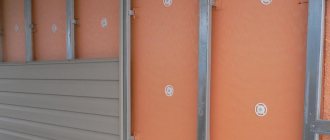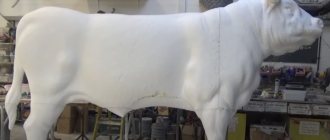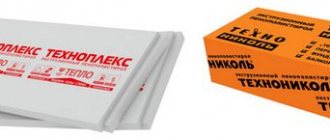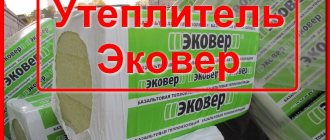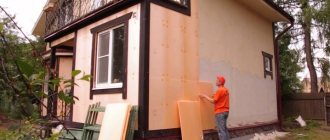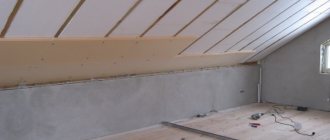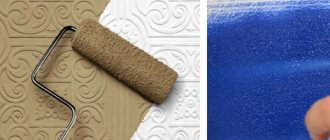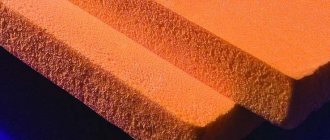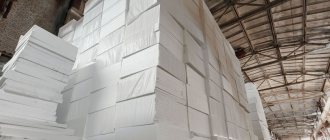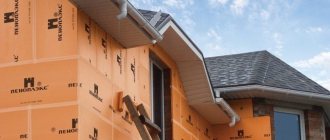Extruded polystyrene foam XPS (EPS) is a relatively “young” thermal insulation material that has gained wide recognition due to its unique combination of characteristics. The material does not shrink, does not absorb moisture and does not swell, and it is also chemically resistant and does not rot. Due to the high strength of polystyrene foam, it is possible to obtain a rigid base for the thermal insulation system, which significantly increases its service life. The material has many more advantages, which is what made it so widespread.
General information
Extruded polystyrene foam (EPS) is an invention of the recent past. In the middle of the last century, American specialists developed an improved synthetic thermal insulation material based on foam plastic, already known here. Construction companies and ordinary people who wanted to insulate their house for the winter quickly appreciated all the advantages of the new super insulation, thanks to which it quickly overtook other materials for insulating rooms in popularity.
These days, extruded polystyrene foam has virtually no competitors in the field of thermal insulation. Thanks to its unique structure, EPS is much stronger than its competitors, it is resistant to deformation and does not deteriorate during long-term storage. We can say that this material is able to cope with unique insulation tasks. It is not for nothing that in the modern market such a product is more in demand than polystyrene foam or polyurethane foam.
How to choose the right seamless ceiling tiles
A beautiful and durable ceiling can only be achieved with the right choice of finishing method. Seamless tiles for the ceiling in this case are no exception, therefore, it is necessary to choose high quality material.
The first thing you need to pay attention to when choosing ceiling tiles for a room is the back surface of the material. There should be no depressions or swellings on it, which indicate a violation of the technological process. Such material may have many hidden defects, which are most often revealed during operation or installation.
Production of extruded polystyrene foam
Expanded polystyrene is made from the same material as polystyrene foam, that is, from foamed plastics. The only difference between EPPS is its foaming technology.
For its production, a special machine is used - an extruder. Polystyrene granules loaded into the extruder hopper are mixed at high temperature, after which foaming components are added to them, and the foamed orange mass begins to be squeezed out under pressure.
Cooled and cut into plates, the orange material, consisting of tiny balls filled with air, becomes the polystyrene foam that each of us can purchase in the store.
The unique foam structure of the material ensures its high thermal insulation properties. How could it be otherwise, if heat transfer occurs exclusively inside the cell with air, while heat transfer from cell to cell is weak due to their small thickness. Moreover, thin and weakly elastic partitions do not transmit sound vibrations well, which determines the high soundproofing properties of this material.
Advantages
To understand for what qualities buyers choose expanded polystyrene, let’s consider the advantages of this thermal insulation material over other insulation materials.
— High thermal insulation properties
In its ability to retain heat, extruded polystyrene foam is superior to almost all known insulation materials, with the exception of polyurethane foam. Its thermal conductivity coefficient is 0.03 W/m*C. This is less than foam, mineral wool and other insulation materials. Only polyurethane foam, for which this indicator is 0.025 W/m*C, can compete with EPPS in the field of heat preservation.
To imagine how high the thermal insulation properties of this material are, it is enough to say that a 30 mm sheet of extruded polystyrene foam retains heat as effectively as 40 mm thick polystyrene foam, 180 mm thick wooden beams, 560 mm thick brickwork or a 1300 mm thick concrete wall!
— Lightness and subtlety
A huge advantage of expanded polystyrene is its lightness. Naturally, it depends on the density of the material, which can be different. So, for example, the density of polystyrene foam brand PSB-S-15 is 10-15 kg/m3. This means that one cubic meter of such insulation weighs only 10-15 kilograms.
The lightness of the material gives an obvious advantage when carrying out construction work. It is convenient to serve such material at a height, and one person can attach it to the wall. And the speed of working with lightweight insulation, especially that produced in the form of slabs, is incomparable with laying mineral wool and other insulation materials.
Add to this the fact that polystyrene foam is an extremely thin insulating material, which only increases its attractiveness in the eyes of the buyer.
— High strength
Despite all the lightness and thinness of the insulation in question, it boasts high mechanical strength. Depending on the density of the produced polystyrene foam, its strength can vary from 25 to 70 MPa. Thus, an EPS board can withstand from 25 to 70 kilograms per 1 meter.
Such high strength allows the use of polystyrene foam as a protective covering for the house, as well as as an underlying layer for floor coverings.
— Low moisture absorption
A valuable quality of this insulation is its ability to resist moisture absorption. This indicator of polystyrene foam does not exceed 0.2%, which means that such material will not get wet even if completely immersed in water. Naturally, it reliably protects the house from moisture penetration.
— Ecological cleanliness
Expanded polystyrene is a synthetic material, but it is absolutely safe for the human body. The environmental friendliness of EPS is evidenced by the fact that children's toys, disposable tableware, protective cases for electronic equipment, etc. are made from this material.
— Durability
Manufacturers claim that extruded polystyrene foam does not change its characteristics even after 50 years of operation. These words can be completely trusted, given that today the material, which has served for 30 years or more, has not lost even 1% of its performance qualities.
— Resistance to critical temperatures
Tests of expanded polystyrene have shown that such a thermal insulation material can withstand temperatures from +75°C to -50°C. Such qualities make it possible to use this heat insulator for insulating houses and structures in the Far North.
— Ability to withstand harmful environmental influences
Expanded polystyrene is resistant to rain and fog, it reliably protects the house from the wind, and fungus and mold do not appear on it. Moreover, such insulation is not of interest to rodents, and therefore, when insulating a house, there is no need to fear that mice will take up residence in the polystyrene foam. True, if they wish, small rodents can easily gnaw a hole in this insulation and enter the house.
Advantages and disadvantages
Today, extruded polystyrene is known as a reliable and practical material that you can trust.
Its relevance is due to many positive qualities, which should be discussed in more detail:
- This material is waterproof. In case of unfavorable contact with liquid, the polystyrene foam floors are filled - no further movement of moisture occurs.
- Extruded polystyrene foam is characterized by a low level of thermal conductivity. If we compare it with other insulating coatings, we can conclude that the thermal conductivity coefficient of EPS is less than or equal to (the only exception to the rule is polyurethane foam).
- A characteristic feature of EPS is low vapor permeability. The coefficient of this parameter is considered to be the minimum among insulating components.
- Expanded polystyrene is not subject to deformation even after a very long time.
- This material is not afraid of temperature changes. In such conditions, it does not lose its useful qualities and remains just as practical/effective. Its operating temperature ranges from -100 to +75 degrees.
- Installation, as well as dismantling of polystyrene foam, is not a difficult task , and it does not take as much time as many people think.
- This material boasts a long service life , during which it does not deform or lose its qualities.
- During operation, extruded polystyrene foam is not subject to destruction.
- Extruded polystyrene foam is not afraid of inorganic solvents.
- Working with this material is very easy and simple, since it is light in weight and thin.
- This material is relatively inexpensive. Many consumers will be able to afford it. In this case, the price-quality ratio cannot but rejoice.
- When laying EPS, you can do without the use of additional hydro- and heat-insulating coatings, which will significantly save money.
- According to experts, XPS is not dangerous to human health. Moreover, when working with it, the master will not experience allergic reactions.
- This material is not afraid of low temperatures , so it is ideal for being in the harsh and changeable Russian climate.
- The durability of extruded polystyrene foam is also confirmed by the fact that it is not susceptible to rotting - not every building and finishing material can boast of this quality.
As you can see, EPS has a lot of advantages. That is why today it occupies one of the leading positions in the market of insulating materials.
However, such a practical and reliable coating also has its own disadvantages, which you should also be aware of before purchasing it:
- This material is subject to combustion.
- When exposed to temperatures above 75 degrees, polystyrene foam can release harmful substances that are hazardous to human health.
- According to experts, this material is afraid of contact with infrared rays.
- EPS can harbor mice, although many manufacturers deny this fact.
- When interacting with various solvents, this material can be destroyed.
If the listed disadvantages do not scare you, then you can safely move on to purchasing this modern material - it is used in many areas.
Flaws
This heat insulator also has some disadvantages. You should also pay attention to them before purchasing.
- High price
If we compare polystyrene foam with other insulation materials, many buyers are put off by its high cost. However, it is formed, among other things, from the advantages of this material, and therefore the purchase of EPS is justified in the long term.
— Destruction from ultraviolet radiation
Expanded polystyrene loses its properties when exposed to direct sunlight for a long time. Therefore, this insulation must be hidden from ultraviolet radiation behind the façade covering.
— Highly flammable
The flammability class of this material is G3-G4. This suggests that, under the influence of an open flame, polystyrene foam begins to burn strongly, but what is even more dangerous, it emits acrid smoke containing toxic substances. We can say that in a state of combustion this material poses a threat to human health.
— Low vapor permeability
Among other things, this material has low vapor permeability, which is good when insulating a bathhouse or sauna, but not very good when insulating a living space. The fact is that by preventing air from entering the room, such insulation will create a “thermos” effect in the house. As a result, to restore a normal microclimate, you will have to ventilate the room more often.
— Destruction from solvents
Under the influence of solvents, the material begins to deform and collapse. This is especially true for solvents contained in bitumen mastics. Therefore, when insulating a house, you should make sure that the EPS is not exposed to aggressive chemicals.
In addition, polystyrene foam can deteriorate when in contact with certain adhesives. Adhesive based on a synthetic solvent will most likely cause the insulation board to shrink, or even soften it altogether.
Choosing adhesive composition for tiles
The durability and attractive appearance of the ceiling space largely depends on the quality of the adhesive composition. It is the glue that affects the ability of the tile elements to adhere to the surface when exposed to high temperatures or high humidity.
When choosing adhesive for seamless ceiling tiles, you should consider the following points:
- The adhesive should not contain solvents that could damage the structure of polystyrene foam. Such adhesive compositions do not always meet the environmental and sanitary requirements applicable to closed premises. It is best to give preference to water-based formulations.
- The main characteristic of tile adhesive is its high degree of adhesion. The composition must ensure proper adhesion of the finishing material and the working surface, regardless of its type.
- The density of the adhesive composition is also of great importance when finishing the ceiling with ceiling tiles. Using thick glue will allow you to securely fasten the elements to the ceiling, preventing them from sliding in different directions. If the consistency of the glue is not thick enough, then first apply the composition to the tile, wait until it dries a little, and then glue the tile to the ceiling.
- At the same time, the glue should not dry quickly so that it is possible to correctly position the tiles on the ceiling.
- Special adhesive compositions have been developed for seamless ceiling tiles made of expanded polystyrene.
Scope of application of extruded polystyrene foam
Eps is a versatile material that is used for a variety of purposes.
— First of all, expanded polystyrene is an excellent insulation material for private housing construction. It is used to insulate the walls of houses (usually inside the house), floors, roofs and even basements characterized by high humidity. By the way, EPS is one of the best insulation materials for concrete floors at home. Experience has shown that this heat insulator is the material of choice when installing “warm” floors.
In private households, extruded polystyrene foam is used to insulate the blind area of a house; it is used to wrap concrete rings of wells to protect them from freezing, as well as any utility lines. To protect pipes, polystyrene foam is produced in the form of a cylinder, shell and other configurations.
— In industrial and municipal construction, polystyrene foam is widely used for insulation of industrial buildings and structures, multi-storey buildings and main lines.
— This material is also used in agriculture for insulation of farms, greenhouses and large vegetable stores.
— Expanded polystyrene is often used for the construction of roads and runways.
— The insulation in question is actively used in the manufacture of industrial refrigeration units and refrigerators.
What it is?
Photo:
Today, the range of various finishing materials is so large that you can simply get lost in its richness.
Thus, one of the most popular coatings, which has many positive qualities, is extruded polystyrene.
This product is a special material of synthetic origin, which was first released in the USA in 1941. Currently, polystyrene is used for a variety of purposes.
It is this raw material that is used for thermal insulation of structures such as foundations and roofs. In addition, extruded polystyrene has good contact with facade plaster.
Where polystyrene foam is not used
1. Extruded polystyrene foam is rarely used to insulate the external walls of houses. The point here is the low vapor permeability rate, which creates a risk of the walls inside the structure getting wet. In addition, it is difficult for expanded polystyrene to compete with polystyrene foam in cost, which is why buyers often choose a cheaper material, albeit with weaker characteristics.
2. Do not cover wooden walls with this heat insulator. Due to low vapor exchange, the tree begins to rot and then rot. If polystyrene foam is used to insulate internal walls in a room, it is additionally covered with a layer of mortar to reduce the fire hazard.
Difference from polystyrene foam
Extruded polystyrene is the same plastic, characterized by a more uniform structure, in which there are many closed cells - their size is about 0.1–0.2 mm.
As a result of mixing all the necessary components and passing them through the extruder, smooth, colorless or colored sheets are obtained. After complete drying, these materials can be used for their intended purpose.
Extruded polystyrene foam has quite a lot in common with polystyrene foam. These products have a similar chemical composition, the main component of which is polystyrene.
As for the functional component, there is no comparison between EPS and polystyrene foam. During production, foam does not pass through an extruder, but for expanded polystyrene this is a standard procedure.
In this case, extrusion gives this material a completely different transformation, and therefore completely different performance characteristics.
Polystyrene foam insulation technology
In order for the material in question to delight you with warmth in your home, it is important not only to choose the appropriate polystyrene foam, but also to lay it correctly. Depending on the surface to be insulated, the technology may differ.
- Laying on a dirt floor
Very often, expanded polystyrene is used as floor insulation, laying sheets of thermal insulation on the ground to lay laminate, parquet or ceramic tiles on top.
To form the floor, a layer of crushed stone or gravel 30-40 cm thick is laid on the compacted soil. A layer of river sand 10 cm thick is laid on top, which is also leveled and compacted. The sand is covered on top with EPS sheets with a stepped edge along the edges. The joints are taped with tape. Expanded polystyrene for floor insulation should have increased strength, and its thickness should vary from 50 to 100 mm. A waterproofing material is laid on top of the EPS, over which a reinforced cement-sand screed is made.
Important! If polystyrene foam is laid in a room with increased mechanical loads on the floor, a concrete screed should be poured under the heat insulator.
- Insulation of concrete floor
It is even easier to lay polystyrene foam on a concrete floor. The main thing is that the base is level. If there are cracks and other damage on such a surface, it is better to pour a sand-cement screed on top, then lay EPS sheets and cover everything with waterproofing. And another screed should be placed on top of the waterproofing.
Important! Expanded polystyrene boards can be laid not only in rooms, but also on the balcony. Please note that such work in an unglazed room is carried out at air temperatures exceeding 5°C.
- Roof insulation
Modern technologies make it possible to efficiently insulate not only walls and floors, but also the roof. It is only important to know some of the nuances of such thermal insulation.
Insulation work should begin when you already have a sheathing, on top of which the roof itself is laid (slate, metal tiles, ondulin, etc.). On the inside of the sheathing, a vapor barrier film should be filled, on top of which expanded polystyrene slabs are laid over the entire roof area. Considering the size of the slabs is 600x1200 mm, they must be tightly inserted between the rafters.
A waterproofing film is laid on the inner surface of the roof over polystyrene foam. It is fixed at the top with internal lathing, and then sheathed with finishing material (plasterboard, board, clapboard, etc.).
- Foundation insulation
In some cases, polystyrene foam is used if necessary to insulate the foundation. At the same time, you can insulate both the foundation of a building under construction and a long-lived house.
First of all, the foundation should be cleaned of dirt, dust and oils. If there are remains of waterproofing on top, these should also be removed. After preparing the surface, you need to apply a waterproofing mixture to it. It is only important that it does not contain bitumen, which can destroy polystyrene foam.
The best heat insulator for such insulation would be polystyrene foam with a density of 35 kg/m2. and higher. To attach EPS boards to the foundation, special adhesive for polystyrene foam is used. After applying the glue, you should wait one minute, then press the insulation onto it, hold it for a minute and begin installing the next slab.
Important! If it is necessary to install a thick layer of polystyrene foam, you can glue one slab on top of another. In this case, it is important that the top layer overlaps the joint of the bottom one. By the way, after the glue has dried, it is additionally recommended to fix the slabs with dowel umbrellas. It is enough to install 6 such fasteners on a sheet.
The top layer of insulation should be covered with reinforcing mesh and sand-cement screed with waterproofing. As an option, the insulation is covered with false panels on top.
- Insulation of internal walls
Extruded polystyrene foam is very often used to insulate walls inside the house. To do this, the walls must first be cleaned of the previous coating and paint materials. After this, they need to be leveled so that the EPS slabs lay flat, without distortion (brick walls need to be plastered).
First, acrylic primer should be applied to the wall, which will not only improve adhesion, but also become a thin leveling layer. Before laying polystyrene foam, the primer must dry for 24 hours. After this, you can mount the slabs to the wall using a special adhesive. The glue is applied to the wall with a roller or brush, and after a minute the EPS sheet is fixed onto it.
It is recommended to start installing polystyrene foam from one of the corners, laying the insulation from bottom to top. If necessary, the slabs should be cut to size. This can be done using a serrated hacksaw or a hot string. As in the case of foundation insulation, the panels, in addition to glue, need to be fixed with dowels.
The joints between the panels should be sealed with foam. A fiberglass mesh, a layer of waterproofing and a layer of plaster are applied on top of such insulation.
- Facade insulation
We have already said that polystyrene foam is rarely used for facades. However, if there is a need to use such insulation, carry out the work as follows:
Clean the wall from paint and other finishing coatings, remove all kinds of irregularities. As with the previous surfaces, apply special glue to the wall, then glue the EPS board to it. After the glue has dried, additionally secure the insulation with dowel umbrellas.
A reinforcing mesh is laid on top of the polystyrene foam, again using an adhesive solution. After it has dried, the surface is primed and façade material, for example, clinker brick, is laid.
Remember that facade insulation should be carried out in the warm season, when humidity is low, because in this case the materials easily adhere to each other.
We do everything in order
Insulation of the outside of a building with expanded polystyrene is best done in dry, warm weather. The order of work will be as follows:
- We prepare the insulated surface by cleaning it from old layers and sealing cracks and chips;
- Prime the wall surface;
- Set the starting bar;
- We install the insulation boards on the surface using adhesive compounds from the bottom up;
- We seal the joints with polyurethane foam (cut off the excess after hardening);
- We install the plaster mesh;
- We cover the insulation with plaster.
Having learned what it is - extruded polystyrene foam, how convenient and economical its use is, one comes to understand the importance of technological progress for increasing the comfort of life of people in general and each person individually.
We also recommend watching a very useful video about the basic principles of insulation:
Popular polystyrene foam manufacturers
The building materials market boasts expanded polystyrene from a variety of manufacturers, both foreign and domestic. Let's get acquainted with the most popular brands.
• Europlex . This company is a leader in the production of thermal insulation for the construction industry. Among Europlex products you can find both stepped and corrugated slabs with a wide variety of physical properties that can satisfy the requirements of the most demanding customer.
• "URSA XPS" . The material from this company is characterized by increased strength, which makes it indispensable for professional construction. If you need polystyrene foam for floor insulation that can withstand increased loads, slabs from URSA are your best choice!
• "Penoplex". This is the largest Russian manufacturer of expanded polystyrene, which produces insulation for both private and industrial buildings, as well as for various utilities. Manufacturers can boast of a variety of forms and types of polystyrene foam at affordable prices, which distinguishes this company from many other manufacturers.
• Stirex. Another Russian manufacturer producing panels for both civil and industrial construction. Styrex cannot boast such a wide range of products as Europlex, but this company produces panels for aviation and road construction. In addition, the company in question pleasantly surprises with its prices.
As you can see, extruded polystyrene foam is a universal material that can become a reliable protection for your home from cold, excess noise and other troubles. With such insulation, installed in compliance with the technology, your home will forget about all the problems for decades!
Polyurethane foam: types, properties, application
Ecowool - properties, application methods, manufacturers
Properties and characteristics
Currently, many large and well-known manufacturers produce extruded material. As a rule, the performance characteristics and properties of different products are almost the same.
This also applies to their dimensional parameters:
- Thus, the thickness of polystyrene foam boards most often ranges from 20 to 150 mm.
- The standard dimensions of polystyrene foam boards are 600 x 1200 mm, 600 x 1250 mm, 600 x 2400 mm.
- Their level of thermal conductivity can range from 0.03 to 0.032 W/mS.
- As for the compression density indicator, at 10% linear deformation it is 150 x 1000 KPa.
- The moisture absorption percentage is typically 0.2–0.4%.
- Flammability class from G3 to G4.
- Vapor permeability level – 0.013 Mg.
- Density – 26–45 kg/cu.m. m.
